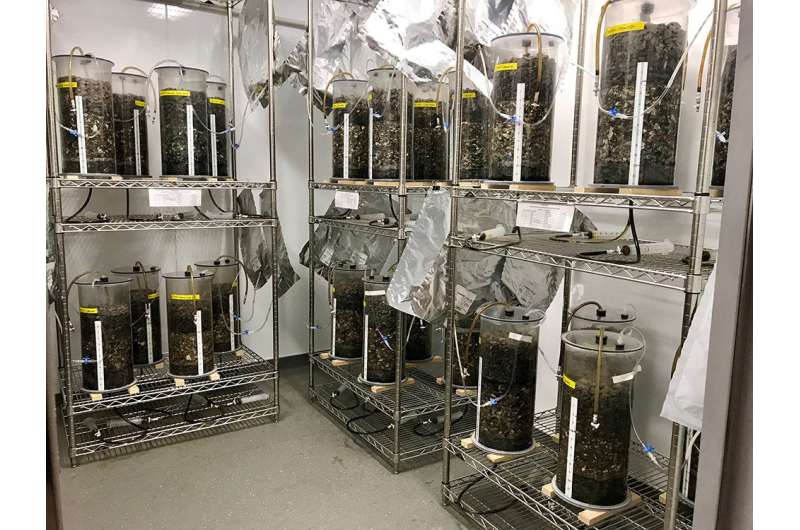Experimental co-disposal waste reactors operating in the Scott Bioengineering Building. Credit: Emily Cook/Chris Bareither
With possible issues rising from the combination of liquid and solid waste in landfills, a new study by Colorado State University researchers could lead to more effective landfill-based management of varied waste streams.
"Landfills are always a tough topic to talk about," said Chris Bareither, assistant professor in the Department of Civil and Environmental Engineering and one of the study's principal investigators. "But waste will never go away, it's our society's problem." Along with Bareither, the team includes civil and environmental associate professor Sybil Sharvelle as co-principal investigator, and two graduate students, Emily Cook and Sajjad Karimi.
The goal of the study is to deliver a set of guidelines to the waste management industry, providing landfill owners a baseline of the potential effects of co-disposing different waste types.
Concerns and benefits of waste co-disposal
The study evolved from concerns about the types of liquid and solid waste being combined in landfills. Some landfill owners have not been concerned with what kind of liquid was being added in, potentially upsetting the stability of the landfill. Misuse of materials leads to both the instability of the landfill and noxious fumes.
If done correctly and safely, a beneficial combination of streams reduces organic waste, leads to better stability for a landfill, and provides greater possibilities of reaching reduction goals. Adding liquid waste to a solid landfill emphasizes anaerobic, or oxygen-free, decomposition across an entire landfill, a good model for the stability of a site. This helps reduce the mass of the landfill, and leads to reclaiming both the land and gasses like methane. Liquid waste can also be a financial gain for landfill owners, as states like Wisconsin pay landfill owners to dispose of liquid waste.
To find combined waste streams which are either problematic or beneficial, the study creates a base set of guidelines of different materials and how they react when co-disposed. For a baseline to be valuable, the team needs to know how the addition of liquid changes reactions in a landfill.
Creating a baseline through experimentation
To create this baseline, the study treats a landfill as a biological reactor of components, modeling a typical landfill through experiments. Under controlled conditions in the Scott Bioengineering Building, Bareither and the team emulate a landfill using large plastic tubes full of different blends of residential refuse and liquid wastes. The team is also experimenting with waste that is becoming more relevant, like oil and gas sludge from drilling.
"To date, the sludge type wastes appear to be the most beneficial to co-disposal," said Cook. "We have observed the greatest methane generation and waste degradation in the sludge waste reactors relative to other experiments."
A goal of the study is to identify wastes that are problematic, including combinations that generate toxic chemicals like hydrogen sulfide or those that impede microbiological degradation. Testing the composition of the resultant liquid and gas from each experiment will lead the team to waste management guidelines.
Delivering guidelines to landfill owners
The guidelines will form a screening test for co-disposed materials, which landfill owners can use to identify both beneficial and detrimental waste combinations. Communities and owners of newer landfills can then plan for their future waste management needs, implementing plans that take into account different waste streams.
Owners of older landfills might also find the guidelines useful, where adding liquid would jumpstart anaerobic reactions in existing organic waste. Communities could reclaim the land and reduce waste, and possibly use recovered methane produced during the reactions for sustainable landfill operations.
"Knowing that we are going to generate waste, where can it go and what we can do better in the end state is a very important conversation," said Bareither. "We can optimize a landfill and work more effectively with it instead of just putting waste in it, covering it up, and leaving it forever."
Provided by Colorado State University





















